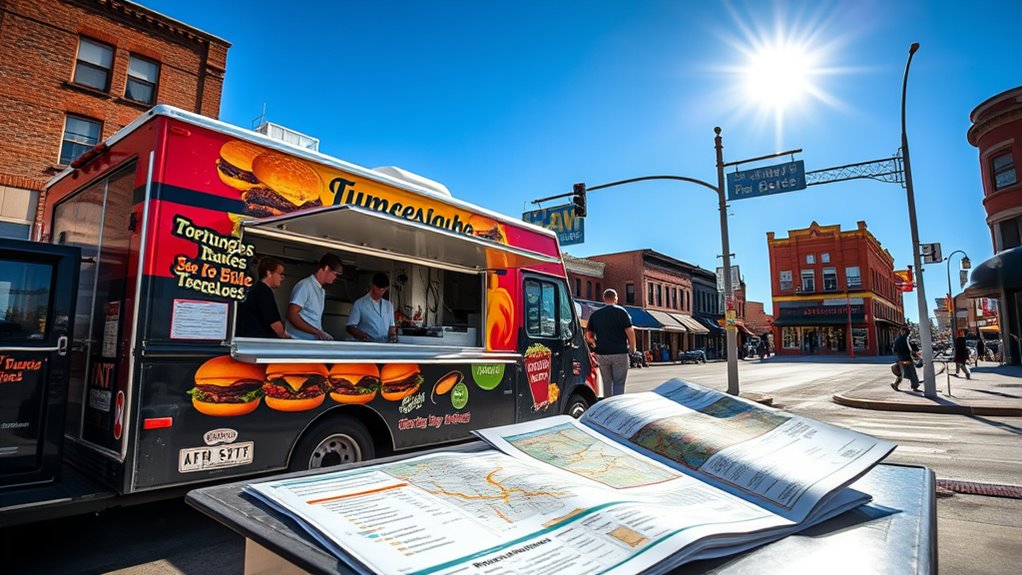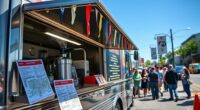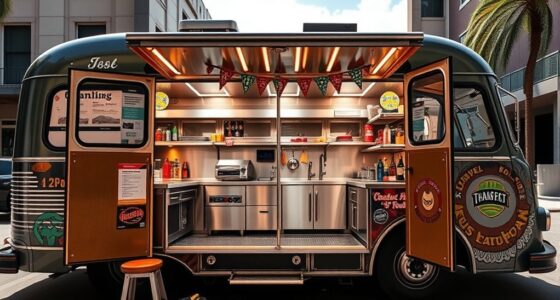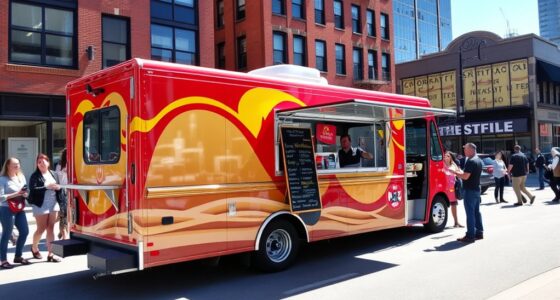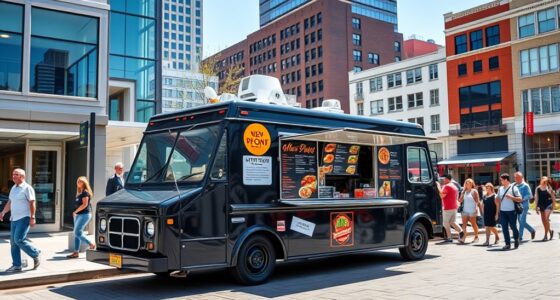To open a food truck in Rapid City, you’ll need to secure permits from the South Dakota Department of Health, budget for startup costs between $15,000 to $50,000 for used trucks, and choose high-traffic locations like downtown or events. Develop a safe, appealing menu that meets health standards and craft effective marketing strategies across social media and local events. Keep compliance in mind for long-term success; exploring detailed steps will give you a strong start.
Key Takeaways
- Obtain necessary permits and licenses from the South Dakota Department of Health, including food service and fire safety approvals.
- Budget for startup costs such as used or new trucks, equipment, licensing, and ongoing monthly expenses like fuel and ingredients.
- Choose high-traffic locations like downtown, near colleges, or at events and festivals to maximize customer foot traffic.
- Develop a safe, compliant menu focusing on temperature-controlled foods, proper labeling, and sanitation practices.
- Utilize social media, branding, and event participation to effectively market your food truck and build a loyal customer base.
Navigating Permits and Licensing in Rapid City

Are you ready to get your food truck up and running in Rapid City? First, you’ll need to complete and submit the South Dakota Department of Health Food License Application, including details about your location, certified manager, opening date, service type, and seating capacity. You also need to fill out the Food Service Plan Review Questionnaire, which describes your menu and kitchen layout, especially if you’re building a new facility. Submit your floor plans 30 days before construction begins, and ensure any large equipment has approved exhaust and fire suppression systems. Equipment and dishwashing facilities must meet state sanitary standards. Once approved, your final inspection will verify compliance before you receive your license. Understanding the licensing process helps you navigate the necessary steps more efficiently and ensures you meet all health and safety standards. It’s important to also review the requirements for food safety standards to ensure compliance with all sanitation regulations. Contact local health advisors for support and clarification throughout the process.
Estimating Expenses for Your Food Truck Venture
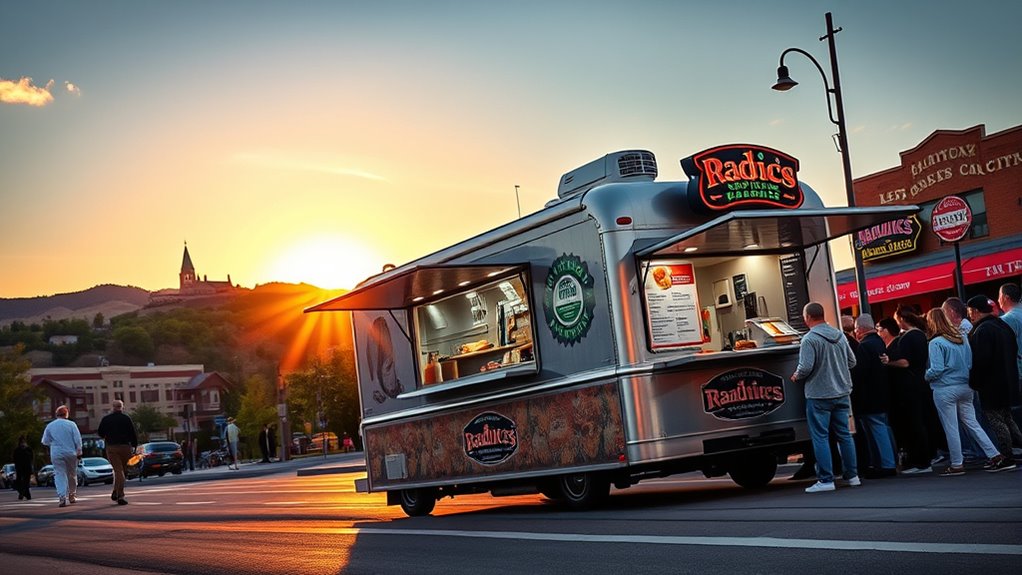
Estimating the expenses for your food truck venture is a crucial step in creating a realistic budget and ensuring your business’s success. Your costs can vary widely, from used trucks at $15,000–$50,000 to new ones up to $200,000. Equipment expenses range from $20,000 to $40,000, and branding costs between $2,500 and $15,000. Licensing and permits average around $1,864 but can be higher locally. Monthly operating costs like fuel, ingredients, and supplies can easily exceed $2,000. Staffing wages, often $12–$15/hour, add ongoing expenses. Allocate funds for marketing—about 12–20% of revenue—to build your brand. Careful planning and budgeting are essential to turn your food truck dream into a thriving business. Considering the vetted equipment and safety standards can help prevent unexpected costs and ensure a smooth operation.
Choosing Prime Locations for Maximum Foot Traffic
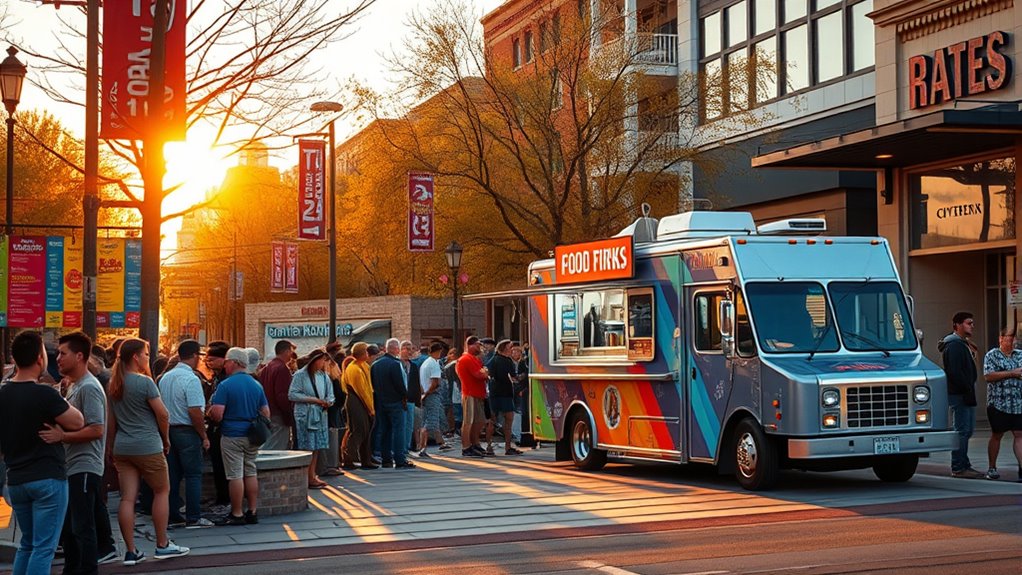
Choosing the right locations can make or break your food truck’s success in Rapid City. Downtown Rapid City sees the highest foot traffic during weekdays and weekends, making it an ideal spot. Events and festivals on Main Street create temporary crowds perfect for quick sales. Nearby colleges draw students at lunch, while shopping plazas generate steady customer flow throughout the day. Parks and recreational areas are especially busy during warm months and weekends. Consider factors like weather, seasonal changes, nearby attractions, and public transportation stops, which influence pedestrian numbers. Be mindful of city permits and restrictions—avoid residential neighborhoods and regulated zones. Collaborate with local events and businesses to boost visibility. Utilizing resources like the StreetFoodFinder platform can help identify trending spots and maximize your exposure. Additionally, understanding the local permitting requirements and regulations ensures you stay compliant and avoid fines. Consistent presence in high-traffic areas builds a loyal customer base and maximizes your success.
Crafting a Safe and Appealing Menu
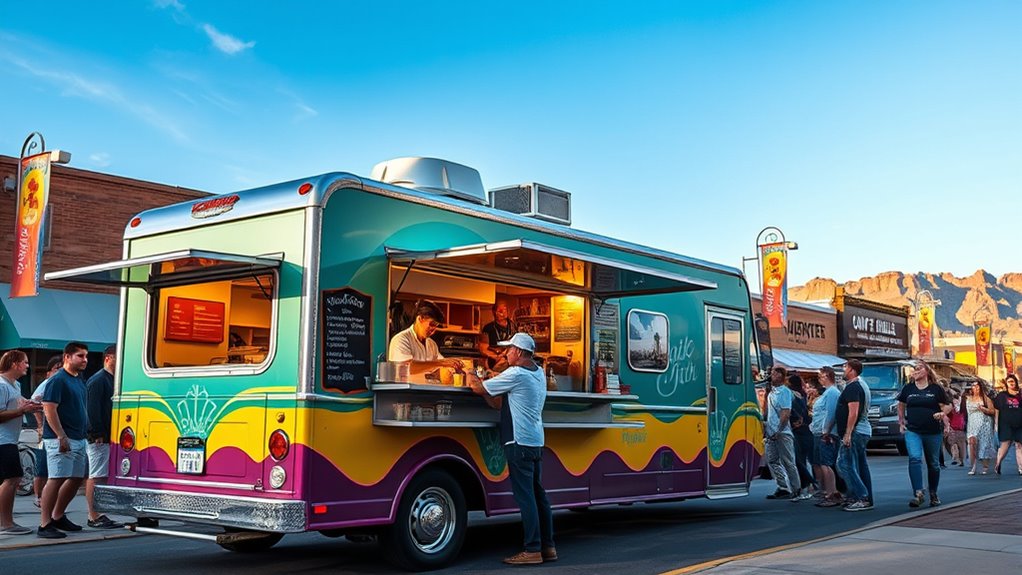
Creating a safe and appealing menu for your Rapid City food truck starts with understanding and adhering to local health regulations. You must guarantee your menu items meet South Dakota Department of Health food safety standards, like maintaining hot foods at 135°F or above. Proper handling procedures are essential to prevent contamination, and all areas must stay clean and sanitary. Keep in mind:
- Use ingredients that are less perishable or can be reliably refrigerated or heated.
- Clearly label all foods with ingredients, allergens, and production dates.
- Avoid overly complex menu items that compromise safety or quick service.
- Prioritize foods safe for transport and storage.
- Train staff thoroughly on hygiene and safe cooking practices.
- Compliance with food labeling requirements is crucial to ensure your menu meets state and federal regulations, avoiding potential penalties and safeguarding customer health.
- Incorporating food safety measures such as proper storage, cross-contamination prevention, and temperature control further ensures your menu’s safety and quality.
Developing Effective Marketing and Customer Engagement Strategies

To attract more customers, you should leverage social media promotions, especially on Facebook, to reach a broad audience and boost sales. Participating in local events and festivals can increase your visibility and create direct engagement opportunities. Additionally, developing strong visual branding strategies helps your truck stand out and leaves a lasting impression. Implementing customer engagement and loyalty programs, such as offering rewards for social sharing or repeat visits, can further enhance your customer retention and expand your reach through positive word-of-mouth boosting customer loyalty. Incorporating research-backed insights into your marketing approach ensures your strategies are effective and sustainable over time.
Social Media Promotions
Effective social media promotions are essential for attracting customers and building a loyal community around your food truck. To maximize impact, choose platforms that match your target audience’s habits. For example, use Instagram and TikTok to reach younger crowds with eye-catching videos and photos. Facebook is perfect for engaging adults aged 25–35 through promotions and reviews, while Twitter provides real-time updates on location, specials, or sold-out items. LinkedIn can boost professional networking and industry partnerships. To boost engagement, post high-quality food photos, behind-the-scenes content, and encourage interaction with polls and contests. Use hashtags and location tags to increase visibility. Promptly respond to comments, share user-generated content, and consider geo-targeted ads to attract nearby customers. This approach keeps your audience engaged and drives foot traffic effectively. Social media algorithms favor consistent posting schedules, so maintaining regular activity can significantly improve your visibility and reach. Additionally, understanding the importance of audience engagement can help tailor your content to foster a more loyal customer base.
Event Participation Opportunities
Have you considered how strategic event participation can boost your food truck’s visibility and customer engagement? Focusing on local festivals, community fairs, and farmers markets in Rapid City helps you reach diverse audiences and maximize foot traffic. Register early for popular seasonal events to secure prime spots, and select those aligned with your cuisine and brand to attract your target market. Enhance onsite engagement with interactive activities like cooking demos or themed nights, and use live entertainment to create a lively atmosphere. Build relationships with event organizers for better placement and cross-promotion, and consider partnering with complementary vendors. Capture customer data through QR codes and loyalty programs to foster repeat business. Proper planning and event logistics are essential to ensure smooth operations and leave a lasting impression. Prepare for weather, logistics, and permits to ensure smooth operations and leave a lasting impression. Proper planning and early registration can significantly improve your chances of success at these events.
Visual Branding Strategies
A strong visual branding strategy transforms your food truck into a memorable, recognizable icon that attracts customers around the clock. Your truck design acts as a 24/7 mobile billboard, boosting visibility and drawing approximately 75% more customers when combined with online marketing. Consistent use of your logo, colors, and messaging across all platforms solidifies brand recognition. Large, bold graphics ensure your truck stands out from a distance, making a lasting impression. A cohesive branding kit—including wraps, menus, and signage—enhances professionalism and customer experience. To maximize impact:
- Use large, bold graphics for visibility
- Maintain consistent branding across all touchpoints
- Incorporate your logo and color scheme everywhere
- Leverage high-quality photos for online marketing
- Engage audiences via social media contests and influencer collaborations
Effective branding visuals are adaptable across various platforms, ensuring your marketing efforts remain cohesive and impactful regardless of where your audience engages with your brand. Additionally, implementing brand consistency across all marketing channels helps reinforce your identity and builds customer loyalty.
Ensuring Ongoing Compliance and Operational Success
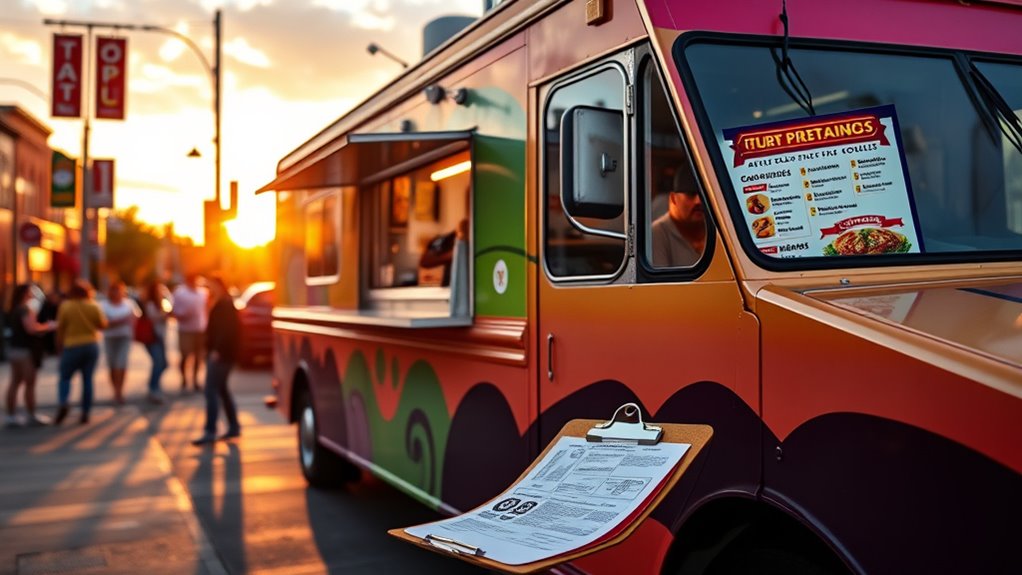
Maintaining ongoing compliance is essential for the long-term success of your food truck in Rapid City. You must keep your State Health Department food licenses up to date, display them clearly, and submit any design modifications for approval. Regular inspections ensure you meet South Dakota’s Food Service Code, and all documentation like insurance certificates and permits must be readily available. Food safety is critical: all prep should happen inside your licensed unit or at an approved commissary, with proper water and waste management. Strict temperature controls, employee certifications, and sanitation routines are mandatory. Additionally, you need valid liability insurance, pass fire safety checks, and adhere to local parking and zoning laws. Keep detailed records of suppliers, procedures, and incident reports to guarantee smooth operations and compliance.
Frequently Asked Questions
How Long Does the Entire Food Truck Permit Process Typically Take in Rapid City?
You’re wondering how long the entire food truck permit process takes in Rapid City. It generally takes about 1 to 2 weeks if you submit a complete application, pass health inspections, and meet all requirements promptly. However, delays can happen if your plans need revisions or inspections are scheduled later. To avoid lengthy waits, prepare all documents early, verify compliance, and stay in touch with local authorities throughout the process.
Are There Any Specific Zoning Restrictions for Mobile Food Vendors in Rapid City?
Imagine you want to set up your food truck near downtown Rapid City. You need to check zoning laws first, as certain areas might restrict commercial food vending. For example, some zones in Pennington County prohibit mobile vendors, and you must operate only on private property with owner permission. Always verify zoning maps and consult local planning departments to guarantee your chosen location complies with Rapid City’s zoning restrictions.
What Are the Most Common Reasons for Permit Application Delays or Denials?
You might face delays or denials if your permit application is incomplete or contains false information. Make certain you submit detailed layout plans, proof of food safety measures, and supporting documents like affidavits or vehicle registration. Noncompliance with health regulations, such as water and sanitation standards, also causes issues. Double-check all details for accuracy, avoid misrepresentation, and respond promptly to any additional requests to prevent processing delays or rejection.
Can I Operate a Food Truck on Public Streets Without a Special Permit?
Imagine trying to sail without a license—you’re unlikely to navigate safely. Similarly, in Rapid City, you can’t operate a food truck on public streets without a proper permit. Current laws require you to have property owner consent and adhere to health regulations. While there’s no explicit “street permit,” violating these rules risks fines or shutdowns. So, guarantee you meet all licensing and consent requirements before hitting the streets.
Are There Financial Assistance Programs Available for New Food Truck Operators?
You’ll find several financial assistance programs available for new food truck operators. Federal grants like USDA’s Business Builder support small and mid-sized food businesses, including mobile ventures, by funding staffing and marketing. Local nonprofits like the South Dakota Community Foundation’s BIG program offer grants to expand food services, especially those with social impact. Community action programs and emergency food distributions can also help build connections and stabilize your venture in Rapid City.
Conclusion
Starting your food truck in Rapid City is like planting a seed that, with the right permits, location, menu, and marketing, will sprout into a thriving oasis. Keep your compliance tight, your menu tempting, and your presence vibrant. As you navigate each step, let your passion be the wind beneath your wings. Soon, your mobile eatery will dance through the streets, serving up success one delicious bite at a time.
